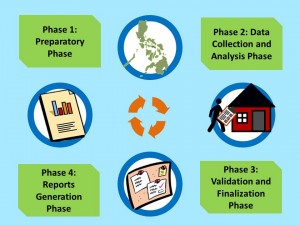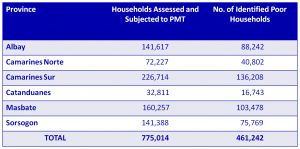LISTAHANAN
by Connie Barrameda | March 7, 2013 11:13 am
 [1]
[1]
Listahanan also known as the National Household Targeting System for Poverty Reduction (NHTS-PR) is an information management system that identifies who and where the poor are.
The system makes available to national government agencies and other social protection stakeholders a database of poor families as basis in identifying potential beneficiaries of social protection programs and services.
Objectives of Listahanan:
1.) Formulate a uniform set of criteria for identifying poor families in the country through specific means;
2.) Facilitate sharing of high quality database to public and private social protection stakeholders;
3.) Reduce leakage or inclusion of non-poor and under-coverage or exclusion of poor from social protection programs and services.
4.) Lessen implementation cost of social protection programs by saving resources intended for targeting.
PROJECT CYCLE
 [2]
[2]
1. Preparatory Phase. The areas to be assessed and their appropriate and corresponding data collection strategies are identified.
2. Data Collection and Analysis Phase. Home visits are conducted to collect socio-economic information and basic information of family members thru the Family Assessment Form (FAF).
FAF is a four-page questionnaire with 46 variables. The data is encoded online at the DSWD regional offices.
A Proxy Means Test (PMT) is run to estimate family income. PMT is a statistical model that estimates the income of families using the proxy variables indicated in the FAF. These include family composition, education of family members, family conditions, and access to basic services. Estimated income of a family is compared to the poverty threshold per province to determine if it is poor or non-poor. Two separate models are used to estimate income for urban and rural households.
3. Validation and Finalization Phase. The initial of poor families are posted for validation at the local level and by forming a Local Validation Committee (LVC) to act on complaints and appeals. The official list of poor households is shared with data users to serve as their guide in selecting beneficiaries of their social protection programs.
4. Report Generation Phase. The National and Regional Profiles of the Poor are generated based on data extracted from the database. Collect feedback from data users as to how they used the data for their social protection programs and resolve appeals or complaints on beneficiary selection.
Listahanan was able to assess and subject to Proxy Means Test (PMT) 10,909,456 households in the 17 regions, 80 provinces, and 137 cities and 1,493 municipalities nationwide. Of these, 5,255,118 households were identified as poor.
RESULT OF HOUSEHOLD ASSESSMENT in Region V
Household Assessed: 775,014
Households identified as poor: 461,242
 [3]
[3]
- [Image]: https://fo5.dswd.gov.ph/wp-content/uploads/2013/03/Listahanan.png
- [Image]: https://fo5.dswd.gov.ph/wp-content/uploads/2013/03/Slide8.jpg
- [Image]: https://fo5.dswd.gov.ph/wp-content/uploads/2013/03/Picture1.png
Source URL: https://fo5.dswd.gov.ph/programs-services/national-household-targeting-for-poverty-reductionnhts-pr/